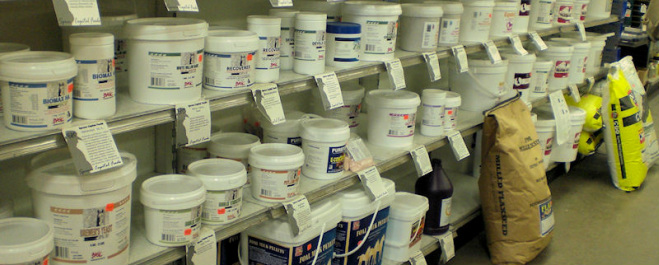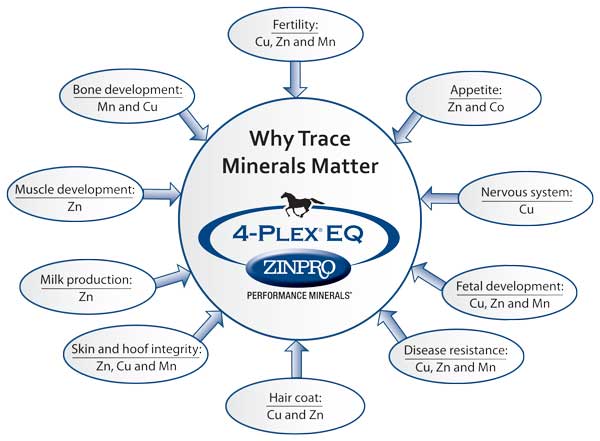Macro Nutrients (needed in larger quantities than the micro nutrients listed below)
A balanced diet is essential in order to provide the horse with all nutrients needed for healthy growth, provide energy for daily activity, keep the horse warm, satisfy appetite as well as their psychological need to chew, and to overall sustain life and maintain health. It is important to understand a horse's nutrition requirements in order to provide them in the correct and necessary balance. Carbohydrates are the horse's main energy source and can be easily converted to and stored as fat when energy intake exceeds requirements. They are made of up carbon, hydrogen and oxygen, and needed for all bodily functions such as breathing, growing, eating, etc. These chemical substances are found in plant cells, which use photosynthesis to harness and store energy from the sun and are stored as both soluble (sugars and fructan) and insoluble (starch and cellulose) carbohydrates. Sugars and starch are broken down by chemical enzymes in the small intestine, while fructans and cellulose are fermented in the large intestine.
Sugars: Main building blocks of complex carbohydrates. Absorbed into the bloodstream after digestion and either transported to cells for immediate use or stored in the liver or muscles.
Starch: The storage carbohydrate found in plants (cereal starch can range from 40% in oats to 70% in corn).
Cellulose: Structural carbohydrates which strengthen plant cell walls. They are fermented by micro-organisms in the large intestine, resulting in the production of volatile fatty acids (VFA's). Common VFA's (such as acetic, proprionic, and butyric acid) are necessary in a horse's diet to maintain normal digestion and to provide energy bulk/roughage.
Starch: The storage carbohydrate found in plants (cereal starch can range from 40% in oats to 70% in corn).
Cellulose: Structural carbohydrates which strengthen plant cell walls. They are fermented by micro-organisms in the large intestine, resulting in the production of volatile fatty acids (VFA's). Common VFA's (such as acetic, proprionic, and butyric acid) are necessary in a horse's diet to maintain normal digestion and to provide energy bulk/roughage.
Lipids are stored within the body in the form of triglycerides (compounds of glycerol and fatty acids) and are primarily stored as subcutaneous fat. Essential fatty acids are ones that need to be provided in the diet and can result in symptomatic deficiencies otherwise. For example, deficiencies in linoleic acid can impair growth, cause skin lesions and lead to both reproductive system and kidney failure. Lipids in the form of oils yield twice as much energy as carbohydrates and have therefore become a common addition to both endurance and performance horses' diets. Dietary fat from corn or oil is easily digested and lessens blood glucose decline post exercise, therefore delaying the onset of fatigue and accelerating recovery. It can also be helpful in reducing a horse's dependence on sugar and starch, such as for azoturia or laminitis.
Proteins are complex organic compounds made up of amino acids. The seven main body proteins include: structural (eg. hair-keratin), contractile (related to muscle contraction), storage (eg. ovalbumin- supplies amino acids to the developing embryo), defense (antibodies), signals (eg. hormones), transport (eg. hemoglobin), and exymes (which promote and regulate most chemical reactions in the body). There are twenty three types of amino acids identified, thirteen of which can be synthesized. The remaining ten are essential and therefore need to be provided in the diet. The quality of a protein is determines by its digestability and split into two categories: those which have a high level of amino acids and therefore a high biological value (such as those found in milk, eggs and soy), and those that don't (cerials are considered to have a low biological value). Since a horse's ability to utilize proteins depends on the available levels of the amino acid lysine, which is provided in inadequate levels in most cereals, it is important to supplement the horses diet according (such as with soya bean meal).
Proteins are complex organic compounds made up of amino acids. The seven main body proteins include: structural (eg. hair-keratin), contractile (related to muscle contraction), storage (eg. ovalbumin- supplies amino acids to the developing embryo), defense (antibodies), signals (eg. hormones), transport (eg. hemoglobin), and exymes (which promote and regulate most chemical reactions in the body). There are twenty three types of amino acids identified, thirteen of which can be synthesized. The remaining ten are essential and therefore need to be provided in the diet. The quality of a protein is determines by its digestability and split into two categories: those which have a high level of amino acids and therefore a high biological value (such as those found in milk, eggs and soy), and those that don't (cerials are considered to have a low biological value). Since a horse's ability to utilize proteins depends on the available levels of the amino acid lysine, which is provided in inadequate levels in most cereals, it is important to supplement the horses diet according (such as with soya bean meal).
|
Vitamin A (retinol)
Functions:
Sources:
Deficiency Signs:
|
Vitamin D (calciferol)
Functions:
Sources:
Deficiency Signs:
* excessive quantities can lead to ossification of soft tissue and hight blood calcium levels. |
|
Vitamin E (tocopherols)
Functions:
Sources:
Deficiency Signs:
* horses with a higher oil intake, require more vitamin E * if deficient in both vitamin E and selenium, liver damage may occur |
Vitamin H (biotin)
Functions:
Sources:
Deficiency Signs:
* cereal biotin is often unavailable to the horse (unable to utilize it) |
|
Vitamin BI (thiamine)
Functions:
Sources:
Deficiency Signs:
|
Vitamin B2 (riboflavin)
Functions:
Sources:
Deficiency Signs:
|
|
Vitamin B6 (pyridoxine)
Functions:
Sources:
Deficiency Signs:
|
Vitamin B3 (niacin)
Functions:
Sources:
Deficiency Signs:
|
|
Vitamin B12 (cobalamin)
Functions:
Sources:
Deficiency Signs:
|
Vitamin C (ascorbic acid)
Functions:
Sources:
Deficiency Signs:
* deficiency is rare but may be seen after an operation or in youngsters. |
|
Folic acid
Functions:
Sources:
Deficiency Signs:
|
Pantothenic
Functions:
Sources:
Deficiency Signs:
|
|
Calcium (Ca)
Functions:
Sources:
Deficiency Signs:
|
|
|
* The Ca:P ratio should be increased during the last term of pregnancy to ensure healthy fetal growth and prevent these minerals from being taken from the mare's skeleton.
* A study done in the Netherlands, examining the influence of calcium intake on phosphorus levels in ponies, found that medium to high Ca levels decreased P digestibility and retention as well as renal excretion (Doorn et. al, 2004). * These two minerals can only be utilized when they are present in a ratio of 2:1, so it is incredibly important to balance their intake appropriately! |
|
Sodium (Na)
Functions:
Sources:
Deficiency Signs:
*lost in sweat |
|
Trace Minerals
|
|
|
|
|



